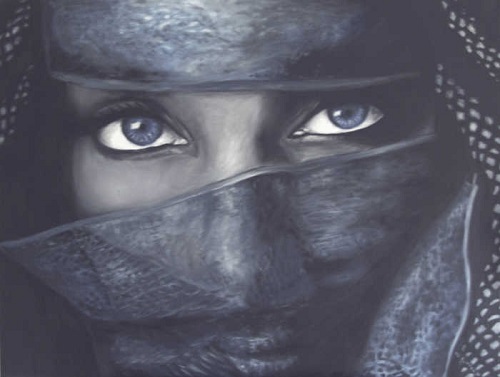FWP:
For a woman to adorn herself was banaa))o-singaar karnaa , and going back into the Sanskrit shringaara there have always been lists of such adornments, often sixteen in number [solah singaar], but sometimes sixty-four. The lists include cosmetics and many kinds of ornaments and jewelry, all named individually.
In the bloody shroud of the martyred lover are not just sixteen or sixty-four adornments, but tens of millions [karo;R]; and even more enjoyably, 'all the tens of millions' [karo;Ro;N], a globally inclusive plural form (think of dono;N in relation to do , tiino;N in relation to tiin , etc.). This gigantic, totalizing number is further emphasized by the pointed contrast with the 'single' [ik] shroud-- though that too might, thanks to the multifariousness of ek , have a wide range of adjectival possibilities.
So we know that the lover's single (but special) bloody shroud not only contains more adornments than any woman would ever be able to muster, but in fact contains every possible adornment in the whole arsenal of beauty tricks. These charms and adornments are not quite in the lover, though-- they're in the blood-dripping shroud itself, the emblem and proof of martyrdom. Why should this be so? The second line tells us, by the power of implication: 'beauty is in the eye of the beholder', and here the beholder is one of the celestial Houris.
The rivalry between the beloved and the Houri is well-known; see for example {100,6} or {159,1}. Here the beloved is being teasingly alerted that the Houri may be casting a predatory eye on 'her' martyrs, those whom she herself has slain or who have died of love for her. (The Houri may be coveting all those 'adornments', too, but it's really the blood-dripping shroud that commands her attention.)
The poor lover, who could never win the affection, or perhaps
even catch the attention, of the beloved, is presented for once in almost
a coquettish light. Even though the beloved had no regard for him when he
was alive, she's just the type to begrudge any share in her prey to a rival.
In the immensely desirable allure of his bloody shroud, the dead lover
may well cause the beloved and the Houri to square off, eyeball to eyeball, and fight to claim possession of him (and the many other martyred lovers in the same situation). It's an amusing vision. What a pity the lover won't
be in a position to take any real advantage of the situation.

Hali:
This verse has both aspects [of love], the Divine [;haqiiqat] and the human [majaaz], but compared with the human, the Divine has been given more force.
==Urdu text: Yadgar-e Ghalib, p. 165